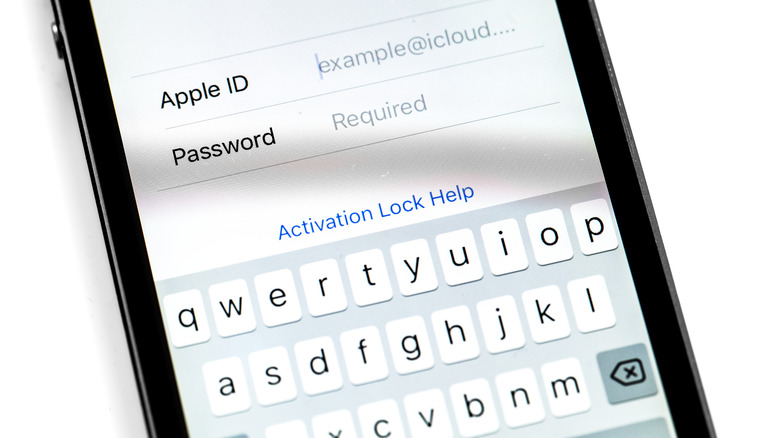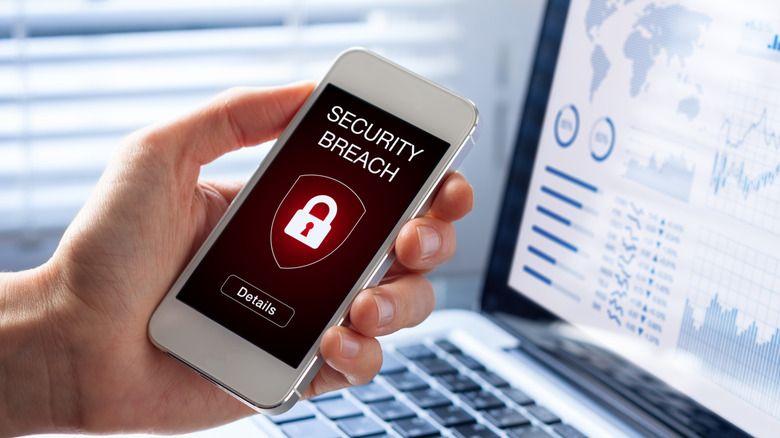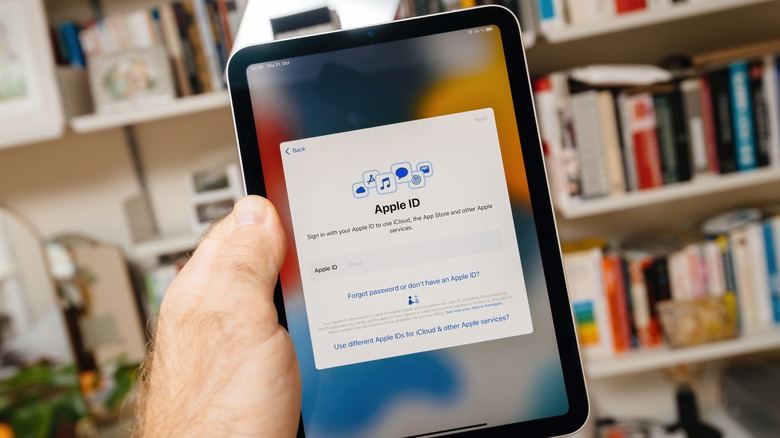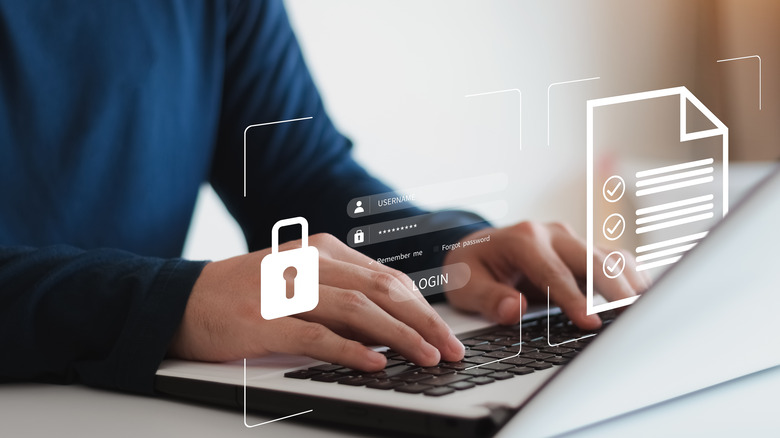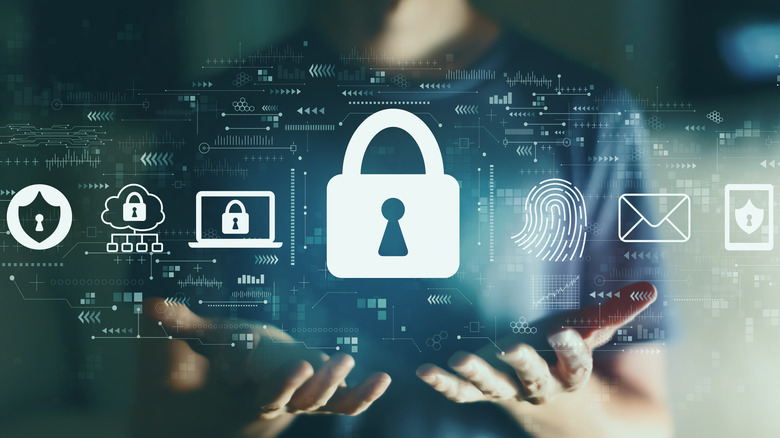Has Your Apple ID Been Hacked? Here's What You Need To Do
Your Apple ID is your passkey into Apple's walled garden; without it, you can't access any of the company's products and services. The account is also how Apple identifies you, and it is linked to a lot of sensitive personal information. This means there's a lot at stake if your Apple ID is compromised. Anyone who has access to it can read your emails and even send emails from your account (if you have an iCloud address). They can access your contacts, see your calendar entries, and view your photos and videos. The intruder can also see any files saved to your iCloud drive, read your Notes, and access your GPS location in real time if you have Find my iPhone enabled.
This is not only a privacy invasion — although that's bad enough — but it could also quickly become a case of identity theft. If you think your Apple ID has been hacked, there are a few ways to know for sure — and, of course, if you find out that you've been hacked, you want to immediately take measures to manage the situation and secure your account. In this article, we'll cover both: how to tell if your Apple ID has been hacked, and what to do to secure your account and prevent such security breaches in the future.
How to tell if your Apple ID has been hacked
Apple has a reputation for providing good security, and the company lives up to it. You'll get an alert if Apple thinks your Apple ID has been compromised; it'll arrive either via email, iMessage, or at the top of the page when you sign in to your Apple account at appleid.apple.com. Each of these threat notifications will include security recommendations for protecting your account. In cases where there is suspicious activity with your Apple ID, Apple might even temporarily disable your account until you authenticate your identity.
The easiest way to know if your Apple ID has been hacked is to check your inbox for an account modification message. If you see any emails notifying you that your password or any other account details have been changed — and you didn't make those changes — then you've been hacked. Your account has also been compromised if you receive an email or notification that your Apple ID was used to sign in to a device you don't recognize or did not sign in to recently (via Apple Support). If you find that your Apple ID has been compromised, you'll need to act fast. In the next section, we'll go over what you must do to prevent any further damage and secure your account.
What to do if your Apple ID has been hacked
If you're certain that your Apple ID has been compromised, there are a few steps to recover a hacked Apple ID account (via Apple Support):
- Sign in to your Apple ID account page (appleid.apple.com). If you have trouble doing that or you get a message that the account is locked or disabled, try resetting the account from your iPhone or any other Apple device you've previously signed in on. To do that, head to Settings, tap your name, then select Password & Security > Change Password, and follow the prompts to reset your password. You could also sign in to your Apple ID account from a new device by selecting "Forgot Apple ID or password?" when it appears during setup.
- Next, change your Apple ID password, and make sure to choose a strong new password. If your password of choice isn't a combination of uppercase and lowercase letters, digits, symbols, and anywhere between 12 to 30 characters, it isn't very strong. If you have trouble coming up with such a password yourself, consider trying a password manager.
- Also, you should review all of your personal details. Go over information like your name, primary Apple ID email, backup emails, and phone number.
- The last and probably the most important security measure is to set up two-factor authentication (2FA) for your Apple ID. Two-factor authentication adds an extra layer of security that prevents access to your account even if your password is breached. You'll have to verify an additional log-in credential with a PIN that you'll get on your phone or a biometric ID. iPhones have a built-in 2FA authenticator tool, so you can ramp up your security with that or use a third-party two-factor authentication app.
If none of these efforts work, you may need to get in touch with Apple Support for assistance in recovering the account. Unfortunately, this process may take multiple days.
Tips for keeping your Apple ID secure
Here are some general security tips to keep your Apple ID secure and prevent any breaches in the future (via Apple Support):
-
Don't share your Apple ID with anyone, not even family members. If you need to share a family subscription, Apple allows you to join with an SMS invite, so you can suggest that to a host if you're ever asked for your Apple ID login details for that reason.
-
Whenever you're visiting your ID account page on a web browser, check for the lock icon in the address bar to verify that the website is genuine and your session is secure.
-
If you ever sign in on a public computer with your Apple ID, remember to sign out when your session is complete to prevent other people from accessing your account. Also, stay away from public Wi-Fi or, if you must absolutely use it, use a Virtual Private Network (VPN).
-
Beware of phishing scams. Phishing is a common scam tactic that hackers use to trick users into giving up their personal details. In the context of Apple IDs, the most popular tactic is to tell a user that their iCloud account has been locked or compromised. Apple sometimes alerts users when their passwords are in danger of compromise, and these attackers send a similar message. Hackers typically include a link in the message that will redirect you to a malicious site where they can steal your data. To keep your info safe, avoid opening links from your SMS or email. Also, make it a practice to hover over any links you receive in emails for a second. You'll see a preview of the destination website that way, and will be able to gauge its authenticity before you open it.
Though it's impossible to completely avoid any risk of having your online accounts compromised, following these steps will greatly reduce the odds of someone else getting ahold of your login information.
Protect your data online
Keeping yourself and your data secure online should be a top priority. The internet is an amazing resource, but unfortunately, hackers and other malicious actors abound online, as well. There's not much we can do to make hackers quit their shady business, but you can definitely learn to protect yourself from any online attack. There is some good news, though: Microsoft, Google, and Apple are working on phasing out passwords for good, and that has major potential to improve user safety online.
While we wait for that solution, do the most you can with the existing security tools. If your security is ever compromised, use the above information to find your way back to safety. The security tips we've mentioned above apply to all other online accounts, not just your Apple ID, so consider making a practice of them as general internet safety measures. You should also teach your kids how to stay safe online, as well.
